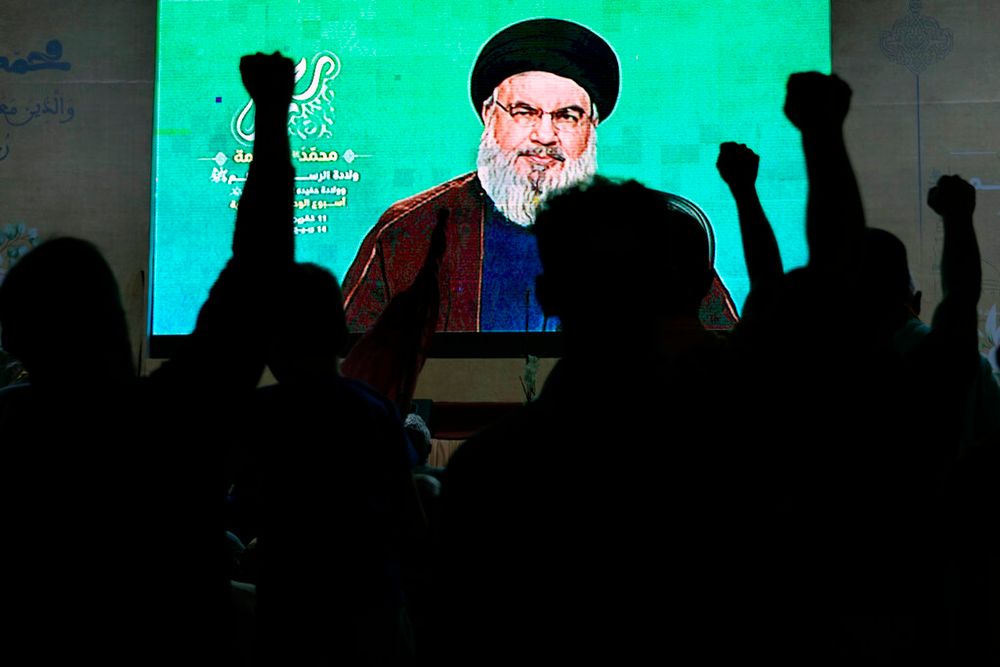News
Hezbollah Leader Threatens to Sink US War Ships With Russian Missiles

Hezbollah leader Sayyed Hassan Nasrallah has warned the United States that his group had something in store for US Navy ships stationed in the region following the outbreak of war last month between the Palestinian party Hamas and Israel, which shook the wider Middle East.
According to individuals acquainted with Hezbollah’s arsenal, powerful Russian anti-ship missiles purchased by the group provide it with the means to carry out its leader’s veiled threat against US warships and highlight the dire hazards of any regional war.
According to two individuals in Lebanon acquainted with Hezbollah’s arsenal, he was alluding to the group’s considerably upgraded anti-ship missile capabilities, which include the Russian-made Yakhont missile with a range of 300 km (186 miles).
According to media and analysts, Hezbollah obtained Yakhont missiles in Syria after deploying there more than a decade ago to assist President Bashar al-Assad in fighting a civil war.
Hezbollah has never admitted to having the weapon.
When contacted for comment on this article, the Shi’ite group’s media office did not react promptly.
Washington claims that the Mediterranean naval deployment, which includes two aircraft carriers and supporting ships, aims to prevent the crisis from spreading by discouraging Iran, which supports groups such as Hamas, Hezbollah, and Palestinian Islamic Jihad.
Because of their ability to strike the group and its allies, Hezbollah sees the US warships as a direct danger.
In a speech on Friday, Nasrallah stated that US warships in the Mediterranean “do not scare us, and will not scare us.”
“We have prepared for the fleets with which you threaten us,” he went on to say.
Following Nasrallah’s Friday statement, the White House stated that Hezbollah must not exploit the Hamas-Israel confrontation, and that the US does not want the conflict to spill over into Lebanon.
According to one of the sources, Hezbollah’s anti-ship capabilities have grown dramatically since 2006, when the group displayed its ability to strike a vessel at sea by hitting an Israeli destroyer in the Mediterranean during a fight with Israel.
“There’s the Yakhont, and of course there are other things besides it,” the insider stated, without going into further detail. The use of this weapon by Hezbollah against US Navy warships would signify that the situation has evolved into a major regional war.
Hezbollah’s capabilities
According to three current and one former US officials, Hezbollah has developed an outstanding arsenal of weaponry, including anti-ship missiles.
“We’re obviously paying a lot of attention to that… and we’re taking whatever capabilities they have seriously,” one official added, without specifically addressing whether the organisation has the Yakhont rocket.
The officials talked anonymously in order to speak openly about Hezbollah’s capabilities.
According to US sources, the recently deployed US naval strength in the region includes defences against incoming missiles. They didn’t go into detail.
The Pentagon has sent warships to the eastern Mediterranean since Oct. 7, when Hamas terrorists assaulted Israel from the Gaza Strip, killing 1,400 people, according to Israel.
According to Palestinian sources, Israeli attacks on the Gaza Strip have killed over 10,000 Palestinians since then.
Nasrallah cautioned Washington on Friday that stopping the Israeli onslaught was critical to avoiding a regional war. Since October 8, Hezbollah has been exchanging fire with Israeli forces along the Lebanese border.
However, Hezbollah has only deployed a portion of its weaponry thus far, and the fighting has primarily been limited to the border area.
Iran backed militants
Other Iran-aligned groups, such as Yemen’s Houthis, have also shot drones at Israel, while Shi’ite Muslim militias backed by Iran have fired on US forces in Iraq and Syria.
According to Reuters the Washington-based Centre for Strategic and International Studies (CSIS), the ground-launched Yakhont approaches its target at low altitude – 10 to 15 metres (yards) off the ground – to escape detection.
According to CSIS, the Yakhont missile, a version of the P-800 Oniks missile first created in 1993, was developed in 1999 for export by a Russian defence contractor and may be launched from the air, land, or submarines.
When asked about the sources’ claims that Hezbollah had obtained Yakhont missiles, Kremlin spokesman Dmitry Peskov stated, “First and foremost, this is news with no confirmation.” We don’t know if it’s true or not.”
“Secondly, we do not have such information.”
The Russian defence ministry did not respond to a written request for comment. The Syrian information ministry did not immediately respond to Reuters’ emailed inquiry.
Nasrallah’s Friday speech was one of his strongest warnings to the US, which holds his group responsible for a suicide attack that destroyed the US Marines headquarters in Beirut in 1983, killing 241 servicemen, as well as a suicide attack on the US embassy that same year, killing 63 people.
While Hezbollah has claimed responsibility for the assaults, Nasrallah alluded to them implicitly in his speech, saying people who beat the US in Lebanon in the early 1980s were “still alive.”
In remarks aired last month on his private YouTube channel, Nasser Qandil, a Lebanese political analyst close to Hezbollah, outlined how the group’s Yakhont missiles could be used against US vessels.
He called the rocket “the most important prize” of Hezbollah’s role in Syria’s civil war, where the group helped turn the tide in Assad’s favour.
“Yes, Hezbollah is prepared and ready,” stated Qandil.
According to two people who spoke to Reuters, Hezbollah got the weapon while fighting in Syria in support of Assad, whose force has long been supported by Russia.
Hezbollah maintains its stockpile and the sources of its weapons under wraps. Nasrallah detailed how the group received Russian-made Kornet anti-tank missiles through Syria in rare statements on the subject in 2021.
News
Britain Must Be Ready for War in 3 Years, Warns New Army Chief

The new head of the Army has stated that Britain must be prepared to fight a war within three years.
Gen Sir Roland Walker has issued a warning about a variety of risks in what he calls a “increasingly volatile” environment.
However, he stated that war was not inevitable and that the Army had “just enough time” to prepare to prevent conflict.
He stated that the Army’s fighting capacity would be doubled by 2027 and tripled by the end of the decade.
Gen Walker warned that the Britain was under threat from a “axis of upheaval” in his first speech as Prime Minister on Tuesday.
Among the primary concerns confronting the Britain in the next years, as noted by the general in a briefing, is an enraged Russia, which may seek vengeance on the West for helping Ukraine, regardless of who wins the war.
He stated: “It doesn’t matter how it finishes. I believe Russia will emerge from it weaker objectively – or completely – but still very, very dangerous and seeking some form of retaliation for what we have done to assist Ukraine.”
Britain’s Government Defence Review and Military Challenges
He also warned that China was determined to retake Taiwan, and Iran was likely to seek nuclear weapons.
He stated that the threats they posed may become particularly acute in the next three years, and that these countries had formed a “mutual transactional relationship” since the war in Ukraine, sharing weaponry and technology.
However, he stated that the path to conflict was not “inexorable” if the UK re-established credible land troops to assist its deterrent strategy for avoiding war.
In his speech, he described his force of slightly over 70,000 regular troops as a “medium-sized army” and made no direct call for additional resources or men.
However, he pushed the British Army to adapt swiftly, focussing on technology such as artificial intelligence and weaponry rather than numbers.
His ultimate goal is for the Army to be capable of destroying an opponent three times its size.
This would entail firing quicker and farther, he said, aided by lessons learnt from the Ukraine war.
The general’s speech at the Royal United Services Institute land warfare conference comes only one week after the government began a “root and branch” defence review to “take a fresh look” at the challenges facing the armed services.
Defence Secretary John Healey launched the assessment, describing the existing status of the armed forces as “hollowed-out” and stating that “procurement waste and neglected morale cannot continue”.
According to the most recent Ministry of Defence (MoD) numbers from April 2024, the Britain’s regular Army forces total 75,325 troops (excluding Gurkhas and volunteers).
That figure has been declining in recent years, as recruiting has failed to match retention. The previous Conservative administration lowered the planned headcount from 82,000 to 72,500 by 2025.
Members of the NATO military alliance have agreed to spend at least 2% of GDP on defence by 2024, but several countries are unlikely to fulfil this goal.
The Britain presently spends 2.3% of its GDP on defence. Prime Minister Sir Keir Starmer has previously stated that the defence review will include a “roadmap” for increasing this to 2.5%, however he has yet to provide a date for this promise.
Source: BBC
News
Katie Ledecky Hopes For Clean Races At Paris Olympics In The Aftermath Of The Chinese Doping Scandal

PARIS — Katie Ledecky is looking for clean Olympic races. On Wednesday, Hope had pretty much reached her limit.
The American swimmer hopes to add to her six gold medals as she competes in the 400, 800, and 1,500 meters at the Paris Games. Her program starts with the heavy 400 on Saturday, featuring Ariarne Titmus and Summer McIntosh.

Katie Ledecky | ESPN Image
Katie Ledecky Hopes For Clean Races At Paris Olympics In The Aftermath Of The Chinese Doping Scandal
The 27-year-old Katie is competing in her fourth Summer Olympics, but the first since a doping scandal involving almost two dozen Chinese swimmers who tested positive for a banned chemical before the Tokyo Games — yet were permitted to compete with no consequences. The controversy has raised serious worries regarding the effectiveness of anti-doping initiatives.

Katie Ledecky | Vogue Image
“I hope everyone here is going to be competing clean this week,” Ledecky claimed. “But what truly counts is, were they training cleanly? Hopefully this has been the case. Hopefully, there has been worldwide testing.”
The International Olympic Committee has expressed concern over the ongoing US investigation into possible doping by Chinese swimmers. While awarding the 2034 Winter Olympics to Salt Lake City on Wednesday, the IOC urged Utah officials to do whatever they could to stop the FBI investigation.
“I think everyone’s heard what the athletes think,” Katie added. “They seek transparency. They want more answers to the remaining questions. At this point, we are here to race. We are going to race whoever is in the lane next to us.
“We are not paid to conduct the tests, so we trust those who follow their regulations. That applies both today and in the future.

Katie Ledecky | ESPN Image
Katie Ledecky Hopes For Clean Races At Paris Olympics In The Aftermath Of The Chinese Doping Scandal
SOURCE | AP
News
London Heatwave Alert: High Temperatures Set to Soar to 29C Next Week

As the summer holidays begin, London may experience an official heatwave with temperatures reaching up to 29 degrees Celsius.
The Met Office predicts a long period of sunny and dry weather for London after a soggy spring and summer.
After a cloudy day on Saturday, temperatures are expected to reach 27C on Sunday, with lots of sunlight.
On Monday and Tuesday, temperatures are forecast to peak at 29 degrees Celsius. Monday is forecast to offer more sunlight, while Tuesday may see some gloomy weather.
Temperatures are expected to remain in the high 20s next week, with lows of approximately 18C.
According to the Met Office, a heatwave is “an extended period of hot weather relative to the expected conditions of the area at that time of year, which may be accompanied by high humidity.”
In the United Kingdom, a heatwave is proclaimed when daily temperatures meet or surpass a certain level for at least three consecutive days.
In London, the heatwave threshold is 28 degrees Celsius.
The Met Office reported that the UK is experiencing hotter and wetter weather on average due to climate change.
The UK experienced its warmest May and April on record this year, despite damp and dismal conditions in many areas.
According to the Met Office’s State Of The UK Climate 2023 report published on Thursday, the UK experienced historic levels of extreme weather last year.
In the United Kingdom, 2023 was the second warmest year on record, bringing storms, flooding, strong heatwaves, and rising sea levels; only 2022 was warmer.
It was 0.8°C higher than the average from 1991 to 2020, and 1.66°C higher than the 1961 to 1990 average.
However, 2023 will be a “cool year” in comparison to 2100, based on the planet’s warming trajectory.
The government’s plan to adapt to the hazards presented by climate change is currently being challenged in the High Court by campaigners who allege the Tory administration’s July 2023 National Adaptation Programme (NAP) fails to adequately address 61 concerns.
Source: The Standard
-
World2 weeks ago
Former President Trump Survives Being Shot at Pennsylvania Rally
-
Tech4 weeks ago
Huawei Launches 5G-A Pioneers Program at MWC Shanghai 2024: Paving the Way for a Connected Future
-
Sports4 weeks ago
NBA Draft: Kyle Filipowski Withdraws Unexpectedly From The First Round
-
Tech4 weeks ago
ChatGPT Answers Undiscovered Questions and Outperforms Students.
-
News4 weeks ago
US Supreme Court Rejects Drug Deal that Protects the Sackler Family
-
Health4 weeks ago
US Health Agency Issues Dengue Virus Infection Warning






















